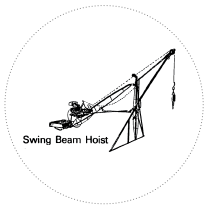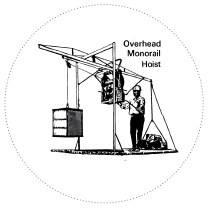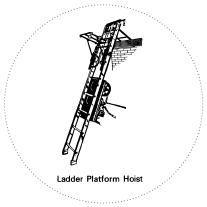
Swing Beam Hoist (A-Frame)
While not fast, this type of hoist is generally sufficient to do most small hoisting jobs. The hoist is operated from the roof with the operator keeping one hand on the frame of the hoist and operating the clutch/brake with the other hand. The hoist beam is hinged to permit the load to be lowered right on the roof.
Trolley Track Hoist
The trolley track hoist is the most common method used to hoist materials to the flat roof. Trolley hoists typically come in two sizes, designated by one manufacturer as TT400, and TT1000. The number signifies the maximum weight capacity of the hoist (in pounds).
Trolley hoists typically come in two sizes, designated by one manufacturer as TT400, and TT1000. The number signifies the maximum weight capacity of the hoist (in pounds).
The winch and pulley are mounted on a carriage that moves along a track. The track can be pushed out to raise and lower loads and pulled back to deposit the loads directly on the deck. The raising and lowering of the loads are controlled by a brake lever and a clutch lever.
Gin Pole Hoist (Hoist Beam)
 The gin pole hoist is used for hand hoisting small amounts of equipment and material. It is most commonly used to hoist the trolley track hoist frame to the roof or for hoisting buckets of “hot stuff” to the roof.
The gin pole hoist is used for hand hoisting small amounts of equipment and material. It is most commonly used to hoist the trolley track hoist frame to the roof or for hoisting buckets of “hot stuff” to the roof.
Ladder Hoist
 The ladder hoist is a heavily constructed steel or aluminum ladder which forms the track for a powered skip that runs up and down the ladder; it is most commonly used by roofers to move supplies quickly up to the roof.
The ladder hoist is a heavily constructed steel or aluminum ladder which forms the track for a powered skip that runs up and down the ladder; it is most commonly used by roofers to move supplies quickly up to the roof.
